|
Characteristics
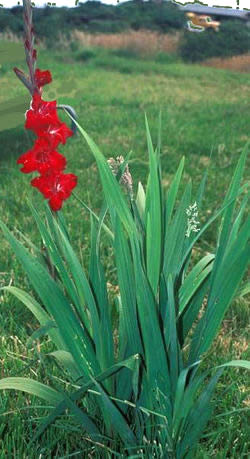
|
Their stems are generally unbranched, producing 1 to 9 narrow, sword-shaped, longitudinal
grooved leaves, enclosed in a sheath.
The fragrant flower spikes are large and one-sided, with secun, bisexual flowers,
each subtended by 2 leathery, green bracts. The sepals and the petals are almost
identical in appearance, and are termed tepals. They are united at their base into
a tube-shaped structure. The dorsal tepal is the largest, arching over the three
stamens. The outer three tepals are narrower. The perianth is funnel-shaped, with
the stamens attached to its base. The style has three filiform, spoon-shaped branches,
each expanding towards the apex.
The ovary is 3-locular with oblong or globose capsules, containing many, winged
brown, longitudinally dehiscent seeds.
These flowers are variously coloured, pink to reddish or light purple with white,
contrasting markings, or white to cream or orange to red.
Gladioli are used as food plants by the larvae of some Lepidoptera species including
Large Yellow Underwing.
Gladioli make very good cut flowers. However, due to their height, the cultivated
forms frequently tend to fall over in the wind if left on the plant.
|
Top
Climate and soil
Gladioli are among the most beautiful flowers, blossoming from October to March
in plains and during June to September in the hills.
Gladioli can be grown in a wide range of soils, light sandy to clay loam. It prefers
sunny situation with pH between 5.5 - 6.5. If the soil is heavy, addition of river
sand and charcoal improves the soil condition.
They grow well both in pot and in beds and the magnificent spikes brighten the garden
and room as cut flower.
Top
Varieties
The two most important types are the large-flowered varieties and the butterfly
or the miniature gladioli. Both types are early, mid-season and late-lowering requiring
65-75 days to 100-120 days for flowering. The butterfly types have small spikes
of various colours and in many cases with dark and attractively coloured throats.
They are ideally suited for small gardens and flower arrangements.
There are a number of varieties in gladiolus. Friendship, Spic and Span, Mansoer
Red, Dr. Fleming, Peter Pears and White Friendship are some of the common varieties.
Varieties evolved in India are Sapna, Poonam, Nazrana, Apsara, Agnirekha, Mayur,
Suchithra, Manmohan, Manohar, Muktha, Archana, Arun and Shobha.
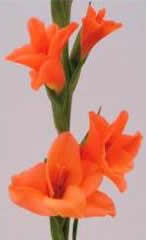
|
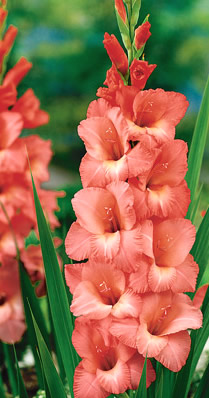
|

|
|
Peter Pears
|
Spic and Span
|
White Friendship
|
Top
Planting
materials
Gladioli are propagated by seeds, corms and cormels. New varieties are raised from
seeds. Seeds germinate freely and the seedlings grown carefully, will flower in
the second year. Large flower spikes, however, develop after 3-4 years when the
corms attain a good size. Gladioli corms are planted 8 to 10 cm deep into the soil,
at a distance of 20-30 cm between the rows and the plants. Application of liquid
manure, once at the vegetative stage and again after the formation of flower buds
has been found very effective.
The flowering spikes appear in 60-90 days after planting, the flowers continue to
open in succession from below upwards and the open flowers remain fresh for a number
of days. After flowering, the leaves begin to turn yellow and wither. The plants
are then lifted with the corms and cormels and kept in a dry shady place for a week
for drying. The corms are thoroughly cleaned, the cormels separated and stored on
a layer of sand in a dry, cool, airy and shady place until the next planting season.
The corms should be examined regularly and those showing sign of rotting or fungus
growth should be removed. They are also stored in cold storage but in a dry atmosphere.
Top
Cultivation
practices
Preparatory tillage
The land is ploughed two or three times and FYM @ 25 t/ha is applied and mixed well
with the soil. Ridges are made 20 cm apart. Fertilizer application is made @ 50:60:60
kg N:P2O5:K2O per ha.
Planting
Gladiolus is generally planted from corms. Corm size ranging from 4-5 cm are selected
and stored in dry, cool well ventilated area. Never keep the corms in direct sunlight.
A medium sized corm (10x12 cm) with a high crown is better than a larger and flatter
corm.

|
|
Corm
|
The corms are planted at a distance of 30 cm and at 5 cm depth. Topdress the crop
with 50 kg N, 45 days after planting, and earth up. Best season for planting is
September-November.
After the planting is finished, cover the soil with straw or small branches. This
is to keep the structure of the soil in good condition, to avoid surface panning,
to keep the soil wet and to avoid excessive high soil temperature.
Irrigation
The crop has to be irrigated once in two or three days depending upon soil and weather
conditions.
Manures and Fertilisers
The plants respond better to organic manure than to artificial fertilizers. After
6 to 8 weeks of planting, the plants may be fed with liquid manure, about once a
week.
At the time of the emergence of flower spikes, a dressing of about 2.5 cm thick
layer of leaf mould is beneficial in producing better flowers with stronger spikes
and better development of corms.
Depending on the macro nutrients content of the soil apply N-P-K after the formation
of forth leaf. Always irrigate after fertilising.
Intercultural operations
-
Earthing: After about 6 to 8 weeks of planting, the plants may be earthed up.
-
Staking: After the emergence of flower spikes, they may be staked, so that the spikes
do not fall down when there is a strong wind. However, staking is not necessary
when the plants are grown closely or in clumps, and it is not needed in the case
of miniature, butterfly or primulinus gladioli. Care should be taken not to injure
the leaves at any stage as the injury is harmful to the plants.
-
In some varieties the corms form two sprouts. Cut one of them at ground level once
the second leaf has formed.
Top
Plant
protection
Gladiolus is attacked by many insect pests. Several species of aphids like green
peach aphid, potato aphid and melon aphid damage developing foliage and flowers.
They can be controlled by using dimethoate. Thrips and caterpillars can be controlled
with dimethoate.
Brown and Fusarium wilts are the major diseases.
Fusarial wilt
It is the most destructive fungal disease in gladiolus seen during rainy season
coinciding with the months between June-October. The symptoms are a yellowing of
the leaves starting with the older outside ones first and this is accompanied by
the apparent stunting of newer leaves. In addition the spike itself will often be
stunted and faded in colour. The plant may also have blackened areas at the base
which spread onto the corm. Eventually, if left, the whole plant will wilt and when
lifted for destruction, (for this is the only course of treatment), the interior
of the corm when opened will appear marbled with a brown colour. Corms are completely
rotten emitting foul smell.
Spraying the crop with 0.03% copper oxychloride or drenching carbendazim 0.5% is
recommended when diseases are noticed.
Pests & Diseases
As plant species go, the gladiolus is relatively free of pests and diseases of epidemic
proportions: however, as with all subjects it is vulnerable to certain fungi, virus
and insect damage. Below is a summary of some of those that are more likely to be
encountered in no particular order of their threat. The common prevention message
as far as all are concerned is to destroy all infected or suspect tissue whether
leaf or corm - do not compost.
|
|
Storage Rot
Corms that have been damaged in some way during the harvesting operation, including
damage caused by the removal of the mother corm, or have not been cured properly
whilst drying can often attract a Penicillin based rot. This rot manifests itself
by the appearance of a fluffy blue or green mould which grows around and over the
area of the wound. Dusting corms with a fungicide will give a degree of protection,
however those corms showing serious levels of deterioration should be disposed of.
|
Caterpillars
Caterpillars can also be a pest and when present will often attack flower buds hewing
a hole through the entire bud and thus the petals held inside. In addition they
may also emerge from the tips of a spike in tight buds generating further holes
which will detract from the beauty of the plant.
|
|
|
Scab
Scab is caused by a bacteria called Pseudomonas marginata. It appears on the corm
as pale yellowish spots which turn brown as the infection worsens, this darkening
of the spots is accompanied by them sinking slightly causing small craters in the
corm. In severe cases there may be seepage of fluid from the crater which will stick
the husks to the corm. This disease can be easily spread from corm to corm so infected
corms should be disposed of by burning.
|
|
|
Stromatinia Rot
This corm disease is caused by a fungus called Stromatinia gladioli and is most
prevalent during periods of cool wet weather and as such can be a particular problem
in northern European climates. The first signs of disease are usually on the growing
plant and are evident by the yellowing of leaves which eventually shrivel and die.
Evidence of the disease on the corms is the appearance of reddish brown markings
which are sunken and if the corm is dissected, dark markings are seen as a marbling
emanating from the centre. A particular problem with this disease is that the fungus
produces an over wintering particles called Sclerotia. As a result diseased corms
should never be planted and as a precaution corms should always be harvested in
dry conditions. If Stromatinia is suspected in growing plants that soil should not
be replanted in subsequent years as the disease is capable of passing from soil
to plant.
|
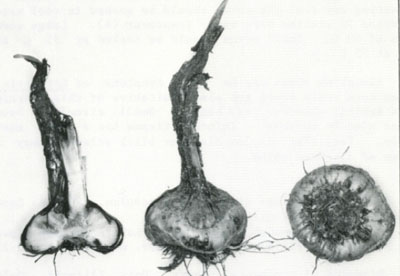
|
|
|
Fusarium Yellows and corm rot
This disease is caused by the fungus Fusarium oxysporum, var. gladioli and is often
referred to as Fusarium yellows or Fusarium Wilt. The symptoms are a yellowing of
the leaves starting with the older outside ones first and this is accompanied by
the apparent stunting of newer leaves. In addition the spike itself will often be
stunted and faded in colour. The plant may also have blackened areas at the base
which spread onto the corm. Eventually, if left, the whole plant will wilt and when
lifted for destruction, (for this is the only course of treatment), the interior
of the corm when opened will appear marbled with a brown colour.
Where Fusarium occurs, fertilize sparingly: nitrogen should be applied in the nitrate
form rather than as ammonia or urea. Soil pH 6.6 - 7.0 preferred. Harvest corms
in dry weather if possible and cure them rapidly using forced air at 80 - 100"F
if available. Inspect stored corms and rogue out suspects.
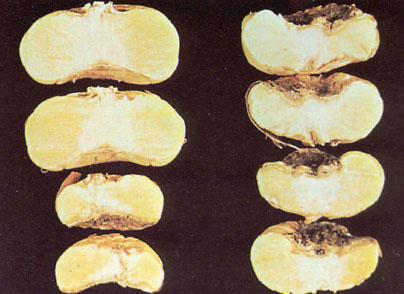
Suspect corms can be sectioned to assess infection in the vascular core
|
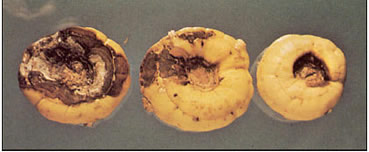
Brown rot in the base of corms is typical of Fusarium
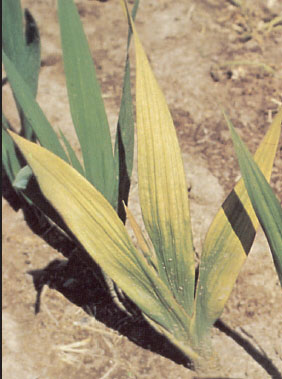
Plant turning yellow is an early symptom of Fusarium
|
|
|
Gladiolus Rust
The Gladiolus rust, Uromyces transversalis is a disease of quarantine
importance in Europe and the United States. Because it attacks mainly hybrid cultivars
it would have serious consequences if it became established in greenhouses or nurseries.
The sori or spore producing bodies are unusual as they develop across the
width of the leaf rather than longitudinally along the veins as in most monocots.
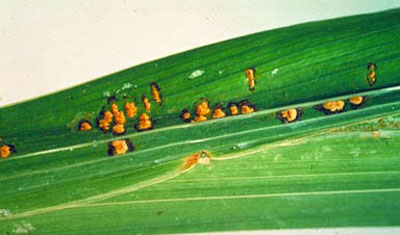
|
At first the sori are covered by the leaf epidermis which soon splits, releasing
the uredospores as shown below:
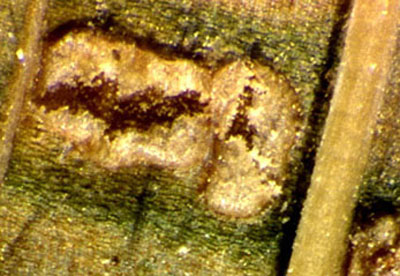
|
|
|
Botrytis
This disease is usually associated with the later part of the season when days are
still warm but nights are cool and there is a large amount of moisture in the atmosphere.
It is usually compounded by a lack of air flow around the leaves of the plant, especially
evident if planted too closely together. The symptoms are small brownish spots on
the leaves which often merge to form larger areas which eventually may develop into
a mouldy grey growth.
Virus
There are many virus diseases which may occur resulting in mottled, streaked or
spotted leaves. The effects on the florets can be patches of colour that are different
from the norm ie white or purplish. In some cases, corms may also be affected becoming
shrivelled.
Some viruses cause cause curling of poor small spikes, small corms and poor root
development. Important to destroy such plants
|
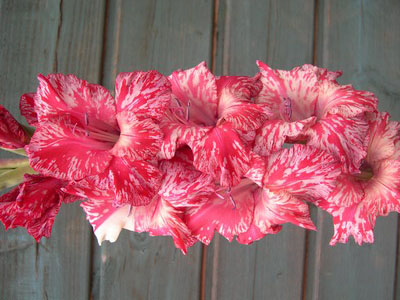
Viruses may cause abnormal colour breaks
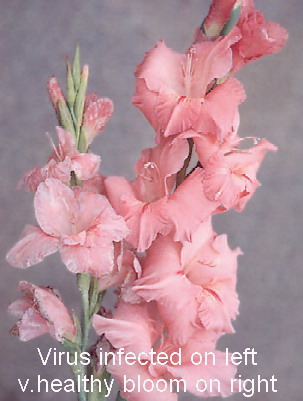
|
|
|
Thrips
The thrip is potentially the worst pest to attack gladiolus - it can also attack
other garden plants. It has the ability to severely damage a whole crop. The symptoms
are not usually noticed until the infestation has occurred and by this time it is
usually too late to rescue the situation. The one saving grace is that the insect
cannot overwinter out of doors in northern Europe and northern North America.
Plants severely infested with gladiolus thrips have a spotted, bleached appearance
with silvery streaking between the leaf margins. Both leaves and petals act as a
food source and will appear withered. If flower buds are seriously damaged, the
flowers fail to open. The entire plant may become stunted.
|

|
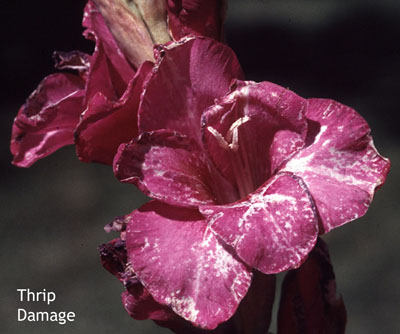
|
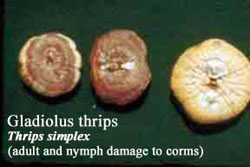
Gladiolus thrips are believed to be an introduced pest from Africa, where gladioli
are native. The thrips are brought in from unmanaged areas in the locality of a
gladiolus patch such as untended allotments, unmanaged hedges or on infested corms.
These thrips can overwinter at any stage of their lifecycle on stored corms or on
plants growing in greenhouses. Although the gladiolus thrips can maintain a population
outside during the summer, they cannot overwinter outside in areas where the temperature
consistently falls below 10° C as a result the monitoring of corms in storage is
extremely important.
|
|
The eggs are opaque, white, kidney-shaped, and about 0.34 mm long and 0.2 mm in
diameter. Gladiolus thrips emerge as creamy yellow larvae, but soon turn dark brown,
except for the tips of the legs which are lighter. The wings are brown above and
lighter below and appear to be darker with a grey band when folded over the back.
Gladiolus thrips are about 1.5 mm long and extremely slim. Males are smaller and
lighter in colour than the females.
The life cycle of the thrip is very much determined by the weather and in warmer
conditions several generations can be produced in a short time hence the apparent
sudden epidemic.
|
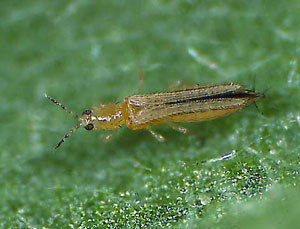
|
|
|
Slugs And Snails
Both slugs and snails can cause damage but in most cases it is purely cosmetic,
however a severe attack to the leaves can affect the plants ability to produce a
new corm for the next season. Slugs have the potential to destroy the growing shoot
of a newly planted corm but once established the plant should be safe from their
clutches. Snails can affect the florets and make them unsuitable for exhibition.
|
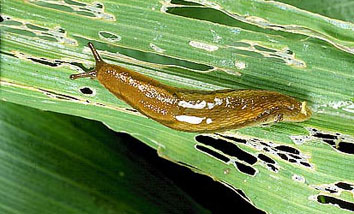
|
|
Top
Harvesting and post harvest operations
The plant starts flowering in 2-3 months after planting based on the variety. The
entire spikes along with two leaves are cut, when the basal flower bud starts opening.
Always cut flowers early morning. Nearly 2 lakh flower spikes can be obtained from
one hectare.
After harvest of flowers, the plants are left undisturbed in the field. When they
start yellowing, the plants are uprooted for harvest of corms and cormels.
Dry the corms in a well ventilated room for no direct sunlight on the corms. After
the drying period remove remaining soil and root. Disinfect the corms and pack in
gunny bags and place them in plastic crates.
Store the corms for a period of 10 to 12 weeks in a cold storage at +20C.
Make sure that there is plenty of ventilation in the cold storage. After twelve
weeks the corms are ready for planting again.
Top
|